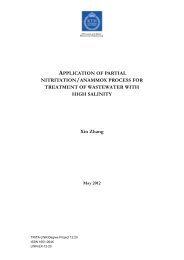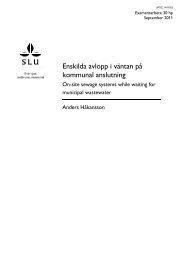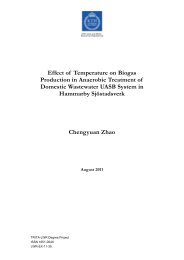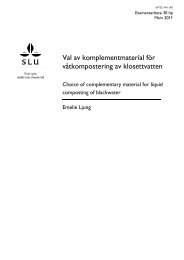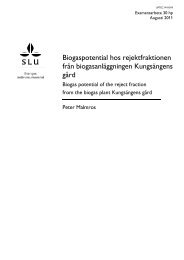Exergy saving and exergy production in municipal wastewater ...
Exergy saving and exergy production in municipal wastewater ...
Exergy saving and exergy production in municipal wastewater ...
You also want an ePaper? Increase the reach of your titles
YUMPU automatically turns print PDFs into web optimized ePapers that Google loves.
<strong>Exergy</strong> <strong>sav<strong>in</strong>g</strong> <strong>and</strong> <strong>exergy</strong> <strong>production</strong> <strong>in</strong> <strong>municipal</strong> <strong>wastewater</strong> treatment<br />
reaction are thermodynamically unfavorable <strong>and</strong> the only drive of the<br />
reactions are to keep the concentration of the hydrogen low.(hydrogen is<br />
the ma<strong>in</strong> product of this step. In the last step which is called<br />
methanogenesis, the methanogenic bacteria use hydrogen gas as one of<br />
the sources to produce methane plus the acetate <strong>and</strong> carbon dioxide<br />
produced from the previous steps. The hydrogen produc<strong>in</strong>g<br />
microorganisms has syntrophic association together with hydrogen<br />
consum<strong>in</strong>g bacteria, which means they need each other <strong>in</strong> order to<br />
cont<strong>in</strong>ue liv<strong>in</strong>g.<br />
The anaerobic digestion can be done by the anaerobic filters, the upflow<br />
Anaerobic Sludge Blanket (UASB), the fluidized <strong>and</strong> exp<strong>and</strong>ed bed<br />
reactors <strong>and</strong> the baffled reactors.<br />
The UASB is the most widely used process which is be<strong>in</strong>g implemented<br />
<strong>in</strong> a reactor that can be circle or rectangular. The flow goes up through<br />
the anaerobic sludge blanket where it loses the organic material. This<br />
blanket consists of flocs <strong>and</strong> highly settleable granules. The organic<br />
material gets trapped <strong>in</strong> the blanket <strong>and</strong> the result is biogas <strong>and</strong> sludge.<br />
The biogas goes up to the top of the reactor where it gets separated by<br />
gas-solid separators.<br />
Only two thirds of the biogas is methane which is highly explosive <strong>and</strong><br />
requires high safety facilities to h<strong>and</strong>le it. Biogas can be used as heat<br />
source or electricity source for the treatment plant; however, <strong>in</strong> order to<br />
use this gas as energy source it has to get purified, which itself is an<br />
expensive process <strong>and</strong> needs to use electrical facilities. But as the price of<br />
the fuel is <strong>in</strong>creas<strong>in</strong>g the usage of the biogas as fuel for vehicles can be<br />
the best way.<br />
Biogas conta<strong>in</strong>s ma<strong>in</strong>ly methane, carbon dioxide <strong>and</strong> smaller amounts of<br />
the hydrogen sulfide <strong>and</strong> ammonia. The gas is saturated with vapor water<br />
<strong>and</strong> there are trace amounts of hydrogen, nitrogen, oxygen, dust, <strong>and</strong><br />
siloxane. The gas purification is be<strong>in</strong>g done <strong>in</strong> order to <strong>in</strong>crease the<br />
energy content of the gas. The presence of the hydrogen sulfide <strong>in</strong> the<br />
gas <strong>in</strong>jected <strong>in</strong>to the pipe leads to the corrosion also the burn<strong>in</strong>g biogas<br />
conta<strong>in</strong><strong>in</strong>g this gas <strong>and</strong> leads to <strong>production</strong> of sulfur dioxide which leads<br />
to acid ra<strong>in</strong>. The presence of the vapor <strong>and</strong> siloxane <strong>in</strong> burn<strong>in</strong>g biogas<br />
form microcrystall<strong>in</strong>e silica deposits on spark plugs, pistons, valves,<br />
cyl<strong>in</strong>der heads <strong>and</strong> metallic surfaces <strong>in</strong> the turb<strong>in</strong>es <strong>and</strong> eng<strong>in</strong>es <strong>and</strong> leads<br />
to foul<strong>in</strong>g <strong>and</strong> abrasion (Greer, 2010).The presence of vapor <strong>in</strong> the gas <strong>in</strong><br />
high amounts leads to <strong>production</strong> of acids <strong>in</strong> the mixtures with H 2S <strong>and</strong><br />
CO 2. This makes it necessary to dry the gas. CO 2 is also the <strong>in</strong>ert part of<br />
the gas which should be removed if the gas is supposed to be used <strong>in</strong> the<br />
pipe l<strong>in</strong>e or as the fuel (Greer, 2010).<br />
1.5. Laws of thermodynamics<br />
In thermodynamic science the world is divided <strong>in</strong>to the system <strong>and</strong> the<br />
surround<strong>in</strong>g. In the environmental science which is study of life forms <strong>in</strong><br />
the biosphere, system is composed of biotic <strong>and</strong> abiotic components<br />
which are <strong>in</strong> <strong>in</strong>teraction with each other (Jørgensen <strong>and</strong> Johansen, 1989).<br />
The system can be <strong>in</strong> three modes consider<strong>in</strong>g its relations with its<br />
exterior world: Isolated system, closed system <strong>and</strong> open system. An<br />
isolated system has the exchange of neither matter nor energy from the<br />
exterior world (there is no real isolated system <strong>in</strong> the world except the<br />
universe itself (Kondepudi, 2008).<br />
A closed system, however, has the ability to exchange energy with the<br />
world outside but not matter. The open system can exchange both<br />
energy <strong>and</strong> matter from the exterior world.<br />
5




